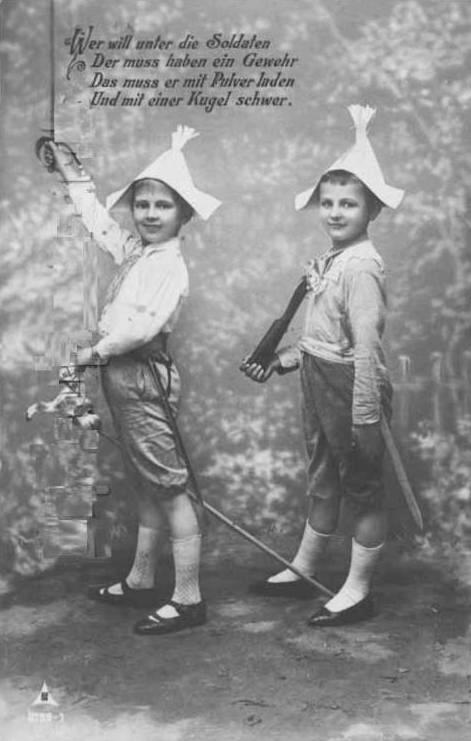
German Militarism: Post Cards

Figure 1.-- Post cards of boys playing war were common before World War I, perhaps more common in Germany, but notable throughout Europe. But note the poem here in this German post card. This postcard is typical of the militaristic attitude in imperial Germany. The German test reads: Wer will unter die Soldaten, Der muss haben ein Gewehr, Das muss er mit Pulver laden, Und mit einer Kugel schwer." That translates as: : Who wants to go among the soldiers, He needs a rifle, That he must load with (gun) powder, And with a heavy bullet." We have noted images from other countries similar to this postcard. We have not noted captions like this anywhere else.
|
|
Exchanging post cardswith interesting images was very popular in the early 20th century. Post cards of boys playing war were common before World War I, perhaps most common in Germany, but German had a very large post card industry, so numerical comparisons are difficult. Such images can be founfd throughout Europe. They were considered cute in the more innocent times beffore the War. We also see a lot od similar post cards in France which also had a large post card industry. The image is rather cute, but it is not the image that struck us here, it is the sentiment or poem that went with it. Note the poem here in this German post card which we found rather jarring. . This postcard is typical of the militaristic attitude in imperial Germany. The German test reads: Wer will unter die Soldaten, Der muss haben ein Gewehr, Das muss er mit Pulver laden, Und mit einer Kugel schwer." That translates as: : Who wants to go among the soldiers, He needs a rifle, That he must load with (gun) powder, And with a heavy bullet." We have noted images from other countries similar to this postcard. We have not noted captions like this anywhere else. A French reader writes, " OK if this post card was edited before the World War I, we could find the same sort of post card in France against Germany." We do not entirely agree with this. Our French reader is absolutely correct that there were ati-German French post cards and highhly patriotic French podst cards focused on the recovery of Alsace-Loraine. But read the poem again. There is not an ounce of anti-French sentiment in the poem or image. It is a poem glorifying war and the military. This is something we have never seen in French, British, or Russian post cards. And we believe it reflects varrying attitudes toward the military in Germany that was outside of the European mainstream.
Exchanging post cards with interesting images was very popular in the early 20th century. This was in part the result of rapidly inproving lithographic techniques, including photo lithography. For the same reason we begin to see photographs depicted in newspapers and magazines. Germany had an especiall large postcard industry and exported cards to other countries. Often the images were German with verses or other text in the language of the importing country. Many of the high-quality postcards used in America before World war I were impoeted from Germany. There were different kinds of cards. Tourists often purchased cards of local landmarks to send home. Here we also see adults and children in folk costumes. There were also sentimental cards with pets and children. These sentimental cards are valuable because they provide a window into popular sentiment just before World war I.
Post cards of boys playing war were common before World War I, perhaps most common in Germany, but German had a very large post card industry, so numerical comparisons are difficult. Such images can be founfd throughout Europe. They were considered cute in the more innocent times beffore the War. We also see a lot of similar post cards in France which also had a large post card industry. There are many similarities in the imagery of the post cards produced in different countries with imaf=ges of boys playing soldier or with toy soldiers. They were primarily presented as charming childhood images. There were also patriotic themes. But what we do not commonly see is cards glorifying the military life per se. We do see patriotic imagery and images glorifying the military in pursuit of country--but not the militsaty iseal. This is something we have never seen in French, British, or Russian post cards. And we believe it reflects varrying attitudes toward the military in Germany that was outside of the European mainstream.
HBC

Navigate the Boys' Historical Clothing Web Site:
[Return to Main World War I German militatism page]
[Return to Main World War I causes page]
[Return to Main World War I page]
[Introduction]
[Activities]
[Biographies]
[Chronology]
[Clothing styles]
[Countries]
[Bibliographies]
[Contributions]
[Essays]
[FAQs]
[Glossaries]
[Images]
[Links]
[Registration]
[Tools]
[Boys' Clothing Home]
Created: 9:52 PM 8/14/2007
Last updated: 12:46 AM 11/28/2008



